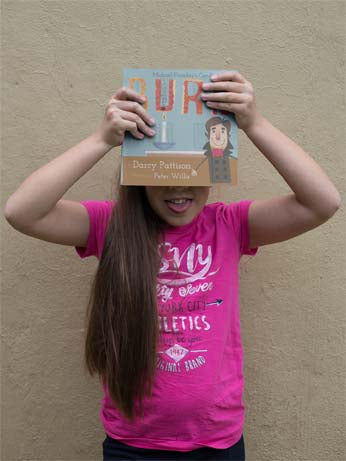





Shipping calculated at checkout
about the book
- by Darcy Pattison
- illustrated by Peter Willis
- 8.5" x 8.5"
- 32 pages
- 4th-5th grade reading level, 840L
Scientist Biography for Kids
Light and Heat Nonfiction Picture Book
Solid wax is somehow changed into light and heat. But how? Travel back in time to December 28, 1848 in London, England to one of the most famous juvenile science Christmas lectures at the Royal Institution. British scientist Michael Faraday (1791-1867) encouraged kids to carefully observe a candle and to try to figure out how it burned. Known as one of the best science experimenters ever, Faraday’s passion was always to answer the basic questions of science: “What is the cause? Why does it occur?”
Since Faraday’s lecture, “The Chemical History of a Candle,” was published in 1861, it’s never been out of print. Oddly, till now, it’s never been published as a children’s picture book. Faraday originally gave seven lectures on how a candle burns. Pattison has adapted the first 6000-word lecture to about 650 words for modern elementary students.
"Good, simple explanation of a complex chemical process. Great enrichment possibilities for teachers. I loved the illustrations, the science, and the British tone. Overall, thumbs up!" Deb Thrall, President, New Mexico Science Teacher's Association
"With this delightful book, Darcy Pattison brings one of Michael Faraday's famous scientific lectures for children to a whole new generation of young learners. Peter Willis' colorful artwork illustrates Faraday's own explanations in a scientific, yet kid-friendly style. This book is a wonderful way to introduce children to this extraordinary scientist and to teach them about changes in matter with a familiar, yet remarkable, object - a candle." - Karen Ansberry and Emily Morgan, Authors of Picture-Perfect Science Lessons
WHO WAS MICHAEL FARADAY?
British scientist and science educator Michael Faraday (1791-1867) worked on understanding electro-magnetic rotations, which is the basis for the electric motor. In chemistry, he discovered two elements, chlorine and carbon. He also experimented with steel alloys and optical quality glass.
IMPORTANT FACTS ABOUT MICHAEL FARADAY
- Michael Faraday is best known as an experimenter. He created experiments to answer questions.
- Michael Faraday worked with magnets, electro-magnetic rotations, chemistry, steel, and glass.
- Michael Faraday invented an early form of the Bunsen burner.
- Michael Faraday presented the British Royal Institution Christmas "Juvenile Lecture" 19 times between 1827 and 1860.
- Michael Faraday's 1860 Juvenile Lecture, "The Chemical History of a Candle" is the most famous science lecture ever given. Since its publication in 1861, it's never been out of print. This children's book is the first time the lecture is recreated in a form for children.
LESSON PLANS
BURN was featured in "Understanding Chemical and Physical Changes," by Christine Anne Royce, Science & Children, January, 2020. You can find this article here. (Free to NSTA members, small charge for others.
MOMENTS IN SCIENCE SERIES - Read More
This eight-book series of nonfiction STEM books highlights biographies of scientists and moments when science changes in some way: a discovery, a new understanding, a new photo, or a Nobel prize award. Scientist's biographies combine with an historical event, and they are wrapped up in clear, concise, and fun explanations of scientific principles. Come and have fun reading an excellent nonfiction picture books.
This series has received a starred review, two NSTA Outstanding Science Trade Books, Junior Library Guild selection, NSSTA Notable Social Studies Book, and the Eureka! NonFiction Honor award (CA Reading Assn.). See the entire MOMENTS IN SCIENCE series here.

